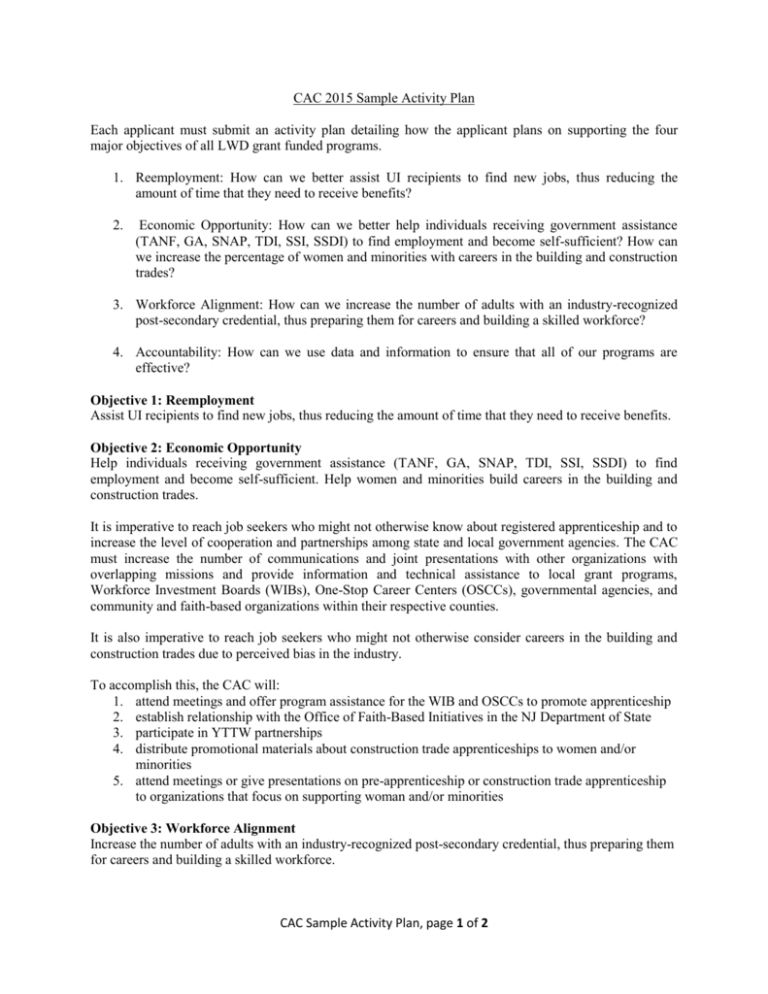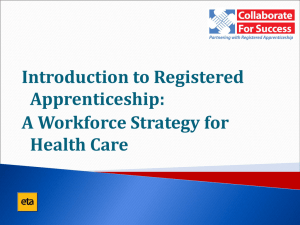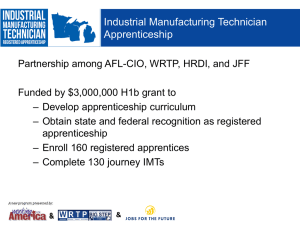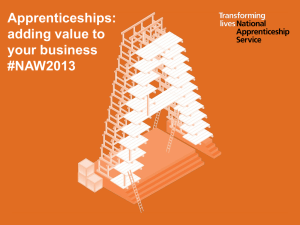Activity Plan - Department of Labor and Workforce Development
advertisement

CAC 2015 Sample Activity Plan Each applicant must submit an activity plan detailing how the applicant plans on supporting the four major objectives of all LWD grant funded programs. 1. Reemployment: How can we better assist UI recipients to find new jobs, thus reducing the amount of time that they need to receive benefits? 2. Economic Opportunity: How can we better help individuals receiving government assistance (TANF, GA, SNAP, TDI, SSI, SSDI) to find employment and become self-sufficient? How can we increase the percentage of women and minorities with careers in the building and construction trades? 3. Workforce Alignment: How can we increase the number of adults with an industry-recognized post-secondary credential, thus preparing them for careers and building a skilled workforce? 4. Accountability: How can we use data and information to ensure that all of our programs are effective? Objective 1: Reemployment Assist UI recipients to find new jobs, thus reducing the amount of time that they need to receive benefits. Objective 2: Economic Opportunity Help individuals receiving government assistance (TANF, GA, SNAP, TDI, SSI, SSDI) to find employment and become self-sufficient. Help women and minorities build careers in the building and construction trades. It is imperative to reach job seekers who might not otherwise know about registered apprenticeship and to increase the level of cooperation and partnerships among state and local government agencies. The CAC must increase the number of communications and joint presentations with other organizations with overlapping missions and provide information and technical assistance to local grant programs, Workforce Investment Boards (WIBs), One-Stop Career Centers (OSCCs), governmental agencies, and community and faith-based organizations within their respective counties. It is also imperative to reach job seekers who might not otherwise consider careers in the building and construction trades due to perceived bias in the industry. To accomplish this, the CAC will: 1. attend meetings and offer program assistance for the WIB and OSCCs to promote apprenticeship 2. establish relationship with the Office of Faith-Based Initiatives in the NJ Department of State 3. participate in YTTW partnerships 4. distribute promotional materials about construction trade apprenticeships to women and/or minorities 5. attend meetings or give presentations on pre-apprenticeship or construction trade apprenticeship to organizations that focus on supporting woman and/or minorities Objective 3: Workforce Alignment Increase the number of adults with an industry-recognized post-secondary credential, thus preparing them for careers and building a skilled workforce. CAC Sample Activity Plan, page 1 of 2 Registered apprenticeship is an employer-sponsored flexible training program that cultivates highly skilled workers who meet the workforce demands of a competitive global economy. Successful completion of a registered apprenticeship results in a post-secondary credential customized to and recognized by an increasing number of industries, from traditional building and construction trades, to advanced manufacturing, information technology, energy tourism, transportation and logistics and healthcare, among many more. The registered apprenticeship model combines work-based learning with classroom instruction. To meet the responsibility of coordinating the classroom instruction for registered apprentices, the CAC must locate and evaluate existing RTI training providers, develop new RTI approved training providers, and support registered apprentices in enrolling in and successfully completing RTI. To accomplish this, the CAC will: 1. assist registered apprentices to locate and enroll in RTI 2. supervise or actively engage in the development of RTI curricula 3. monitor the progress of registered apprentices in their RTI and keep records up to date 4. assign make up classes 5. prepare/coordinate requests for completion 6. assist apprentices changing employers to notify USDOL of employer change to ensure continuity of apprenticeship 7. maintain office hours designated for registered apprentices, sponsors, and other stakeholders 8. send up-to-date lists of RTI courses to LWD for inclusion in shared database 9. monitor online courses and administer online tests 10. engage in professional development by participating in quarterly association meetings, conference calls, and other meetings, seminars, training programs, and conferences 11. promote and market apprenticeship to potential apprentices and sponsors 12. visit worksites throughout county and set up meetings with employers to talk about apprenticeship opportunities and learn about emerging trends in their occupational fields. 13. report sponsor interest and trends to USDOL and LWD Objective 4: Accountability Use data and information to ensure that all of our programs are effective. In order to increase the number of official, industry recognized credentialed employees, the RTI curriculum must comply with the apprenticeship plan and meet all requirements and registered apprentices must complete the minimum 144 required RTI hours with passing grades. The CAC will maintain county copies of records of registered apprentices, track their progress quarterly, and notify the USDOL-OA when registered apprentices are not meeting their RTI goals. To accomplish this, the CAC will: 1. maintain and file county apprenticeship program records in hard copy and enter statistics into a database or spreadsheet 2. follow up with apprentices who should have completed to determine status 3. track status of registered apprentices on a quarterly dashboard 4. notify sponsor, apprentice, and USDOL-OA of completions and failures or drop outs and recommend appropriate action (extend, cancel, completion in process) CAC Sample Activity Plan, page 2 of 2








